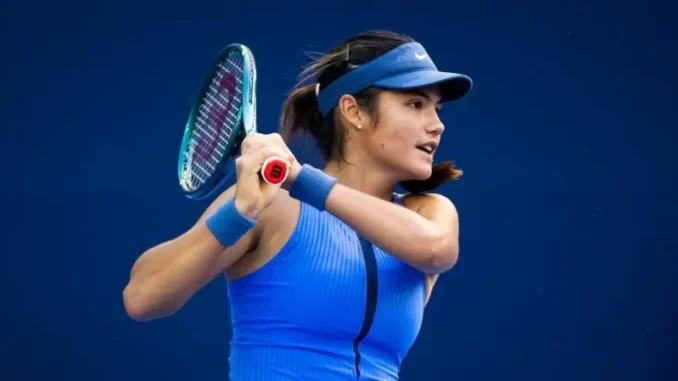
Beneath Beijing’s storied Great Wall, where history meets ambition, Emma Raducanu took to the Lotus Court at the 2025 China Open carrying both heritage and expectation. At 22, the British star—her mother’s Chinese roots tying her to this land—stepped onto the WTA 1000 stage as more than a player, but a symbol of bridged worlds. Her debut, a long-awaited homecoming, pulsed with promise. Fans, some holding Mandarin signs echoing her fluent post-match responses, filled the stands with fervor. Ranked No. 32 with a 28-19 season record, Raducanu had rekindled sparks of her 2021 US Open triumph—a qualifier’s miracle of power and grace. Yet, on September 29, under a fading autumn sun, her third-round clash with world No. 7 Jessica Pegula unraveled into a familiar heartbreak, deepening fears of a troubling pattern.
The stage was set for something special. Seeded 30th with a first-round bye, Raducanu dispatched Spain’s Cristina Bucsa 6-3, 6-3 in round two, her serve booming and groundstrokes slicing through Beijing’s thin air. Her first win on these courts felt like a declaration. Speaking flawless Mandarin on-court, she captivated the crowd, her mother Renee a steady presence in the stands. Under new coach Francisco Roig, once Rafael Nadal’s mentor, Raducanu looked sharper, fitter, her movement honed over two months of grueling preparation. Her season—upsets over Naomi Osaka and Maria Sakkari, a dogged Australian Open third-round showing against Iga Swiatek, and a near-miss against Aryna Sabalenka in Cincinnati—showed growth. With $1.3 million in prize money and a game growing bolder, Beijing seemed primed for her next breakthrough: a top-10 win to propel her toward the WTA Finals and quiet the doubters.
Then came Pegula, a relentless American whose baseline precision and clutch play thrive in high-stakes moments. Their third encounter—Pegula up 2-1 after a Miami quarterfinal epic—ignited the court for 2 hours and 23 minutes. Raducanu stormed to a 6-3 first set, breaking twice with blistering forehands and a sly backhand slice. She owned the tempo, her enhanced fitness evident as she prowled the court. The second set boiled into a tiebreak: Raducanu surged to 5-2, then earned three match points at 6-3. Victory seemed hers. But Pegula, battle-hardened from her WTA Finals run, clawed back—an ace, a desperate lob, a pinpoint cross-court winner stealing the tiebreak 11-9. Raducanu’s spark dimmed. The third set was a 6-0 demolition, Pegula capitalizing on errors and faltering serves as Raducanu faded. A quick wave to the stunned crowd, and she was gone, her mother’s eyes reflecting both pride and ache.
This wasn’t a standalone stumble—it was a haunting rerun. A week earlier in Seoul, Raducanu followed the same script against Barbora Krejcikova, the 2024 Wimbledon champion: a 6-4 first-set win, three match points in a 12-10 second-set tiebreak loss, then a 6-1 third-set collapse. Social media buzzed with déjà vu. “First set won, break up in the second, match points, then…” one X post vented, paired with scorelines that echoed losses to Elina Svitolina, Elena Rybakina, and Sabalenka. Fans and analysts pinpointed the issue: pressure. “She overthinks match points, then her head drops,” one user wrote, a view liked thousands of times. Others saw progress, noting her ability to push top players with improved stamina. Pre-tournament murmurs—Raducanu cutting practice short, citing discomfort—faded as she powered through Bucsa, but questions lingered: was it mental fragility or physical limits unraveling her in crunch moments?
Voices of experience amplified the concern. Former British No. 1 Annabel Croft, commentating on the loss, sounded a warning: “You must address these patterns before rivals exploit them in the locker room.” Croft, once world No. 24, saw Raducanu’s composure post-tiebreak—a brief pause to reset—as a step forward, but cautioned against rhythm-breaking breaks. The pattern, though not unique, risks defining her. After ankle surgeries and coaching changes in 2022-2023, this season’s 28-19 record shows resilience, but the collapses demand a fix.
As the China Open continues—Britain’s Sonay Kartal charging to the fourth round with a 6-3, 6-2 win over Maya Joint—Raducanu regroups. The Asian swing fades, with European indoor courts and the Australian Open ahead. A top-20 push and WTA Finals hopes hinge on breaking this cycle. Her Mandarin charm won Beijing’s heart, but her racket must silence the skeptics. These losses aren’t just defeats—they’re clues, pointing to a mental or physical edge yet to be sharpened. Fans, fiercely loyal since her US Open glory, see the fire still burning. In tennis’s crucible, where champions rise from setbacks, Raducanu’s next chapter awaits. The baseline calls, and with it, a chance to rewrite the narrative and seize what keeps slipping away.
Leave a Reply